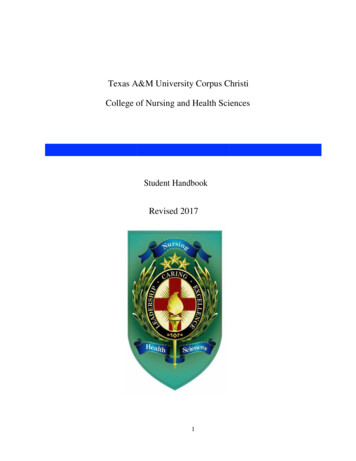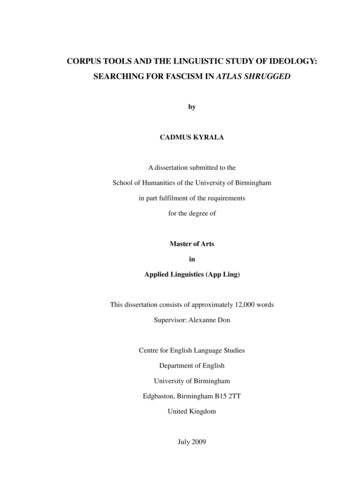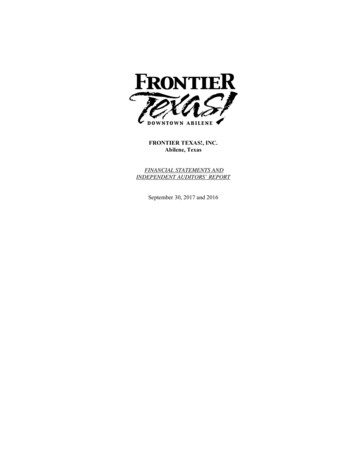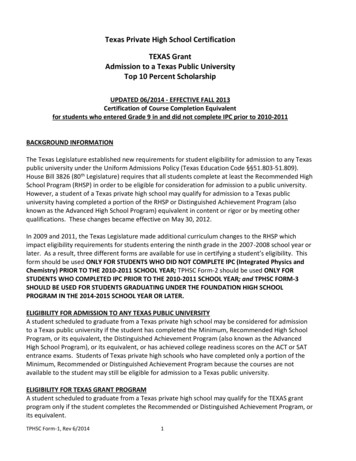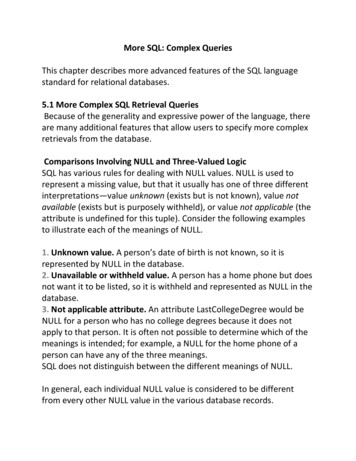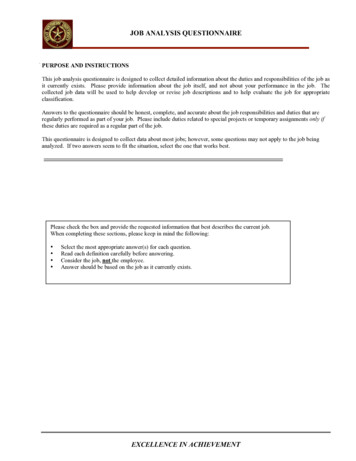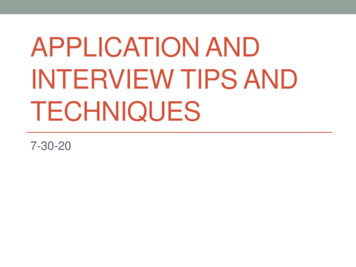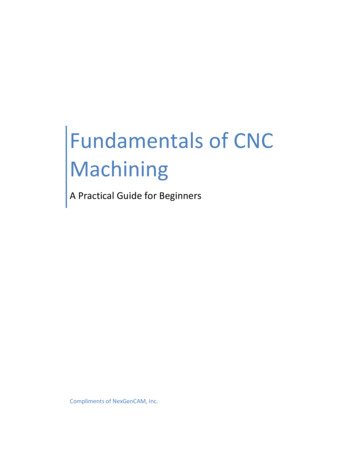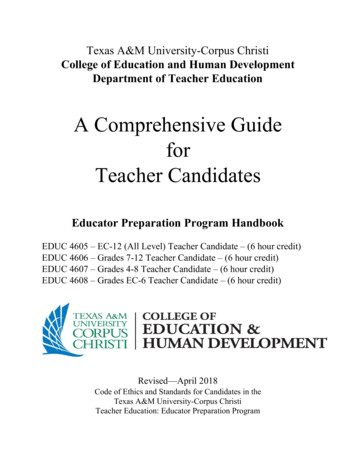
Transcription
Texas A&M University-Corpus ChristiCollege of Education and Human DevelopmentDepartment of Teacher EducationA Comprehensive GuideforTeacher CandidatesEducator Preparation Program HandbookEDUC 4605 – EC-12 (All Level) Teacher Candidate – (6 hour credit)EDUC 4606 – Grades 7-12 Teacher Candidate – (6 hour credit)EDUC 4607 – Grades 4-8 Teacher Candidate – (6 hour credit)EDUC 4608 – Grades EC-6 Teacher Candidate – (6 hour credit)Revised—April 2018Code of Ethics and Standards for Candidates in theTexas A&M University-Corpus ChristiTeacher Education: Educator Preparation Program
Table of ContentsCode of Ethics and Standard Practices for Texas Educators2Educator Preparation Program Continuation and Dismissal Policy4Educator Preparation Program Continuation Plan (Part A)5Educator Preparation Program Continuation Plan (Part B)6TAMUCC Teacher Education Contract7Teacher Candidate Consent Form8State Board for Educator Certification (SBEC) Teacher Standards9PPR Domains and Competencies14Technology Standards23Coming To Terms With Terms24Program OverviewMission and ObjectivesPhilosophical OverviewField Experience OverviewCo-Teaching ModelCoaching Model252525262728Teacher CandidatesProfessional GuidelinesTeacher Candidate ExperiencesAssessment of Professional Attributes30303233Roles and ResponsibilitiesProblem-Solving ProtocolsPolicies And Legal Issues For Teacher CandidatesLiabilityAbsencesContact 3939401
Code of Ethics and Standards for Candidates in theTexas A&M University-Corpus ChristiTeacher Education: Educator Preparation ProgramBased on RULE §247.2 Code of Ethics and Standard Practices for Texas EducatorsEnforceable Standards.(1) Professional Ethical Conduct, Practices and Performance.(A) Standard 1.1. The educator shall not intentionally, knowingly, or recklessly engage in deceptive practicesregarding official policies of the school district, educational institution, educator preparationprogram, the Texas Education Agency, or the State Board for Educator Certification (SBEC) andits certification process.(B) Standard 1.2. The educator shall not knowingly misappropriate, divert, or use monies, personnel, property, orequipment committed to his or her charge for personal gain or advantage.(C) Standard 1.3. The educator shall not submit fraudulent requests for reimbursement, expenses, or pay.(D) Standard 1.4. The educator shall not use institutional or professional privileges for personal or partisanadvantage.(E) Standard 1.5. The educator shall neither accept nor offer gratuities, gifts, or favors that impair professionaljudgment or to obtain special advantage. This standard shall not restrict the acceptance of gifts ortokens offered and accepted openly from students, parents of students, or other persons ororganizations in recognition or appreciation of service.(F) Standard 1.6. The educator shall not falsify records, or direct or coerce others to do so.(G) Standard 1.7. The educator shall comply with state regulations, written local school board policies, and otherstate and federal laws.(H) Standard 1.8. The educator shall apply for, accept, offer, or assign a position or a responsibility on the basis ofprofessional qualifications.(I) Standard 1.9. The educator shall not make threats of violence against school district employees, school boardmembers, students, or parents of students.(J) Standard 1.10. The educator shall be of good moral character and be worthy to instruct or supervise the youthof this state.(K) Standard 1.11. The educator shall not intentionally or knowingly misrepresent his or her employment history,criminal history, and/or disciplinary record when applying for subsequent employment.(L) Standard 1.12. The educator shall refrain from the illegal use or distribution of controlled substances and/orabuse of prescription drugs and toxic inhalants.(M) Standard 1.13. The educator shall not be under the influence of alcohol or consume alcoholic beverages onschool property or during school activities when students are present.(N) Standard 1.14. The educator shall not assist another educator, school employee, contractor, or agent inobtaining a new job as an educator or in a school, apart from the routine transmission ofadministrative and personnel files, if the educator knows or has probable cause to believe that suchperson engaged in sexual misconduct regarding a minor or student in violation of the law.(2) Ethical Conduct Toward Professional Colleagues.(A) Standard 2.1. The educator shall not reveal confidential health or personnel information concerningcolleagues unless disclosure serves lawful professional purposes or is required by law.(B) Standard 2.2. The educator shall not harm others by knowingly making false statements about a colleague orthe school system.(C) Standard 2.3. The educator shall adhere to written local school board policies and state and federal lawsregarding the hiring, evaluation, and dismissal of personnel.(D) Standard 2.4. The educator shall not interfere with a colleague's exercise of political, professional, orcitizenship rights and responsibilities.(E) Standard 2.5. The educator shall not discriminate against or coerce a colleague on the basis of race, color,religion, national origin, age, gender, disability, family status, or sexual orientation.(F) Standard 2.6. The educator shall not use coercive means or promise of special treatment in order to influenceprofessional decisions or colleagues.(G) Standard 2.7. The educator shall not retaliate against any individual who has filed a complaint with the SBEC2
or who provides information for a disciplinary investigation or proceeding under this chapter.(3) Ethical Conduct Toward Students.(A) Standard 3.1. The educator shall not reveal confidential information concerning students unless disclosureserves lawful professional purposes or is required by law.(B) Standard 3.2. The educator shall not intentionally, knowingly, or recklessly treat a student or minor in amanner that adversely affects or endangers the learning, physical health, mental health, or safetyof the student or minor.(C) Standard 3.3. The educator shall not intentionally, knowingly, or recklessly misrepresent facts regarding astudent.(D) Standard 3.4. The educator shall not exclude a student from participation in a program, deny benefits to astudent, or grant an advantage to a student on the basis of race, color, gender, disability, nationalorigin, religion, family status, or sexual orientation.(E) Standard 3.5. The educator shall not intentionally, knowingly, or recklessly engage in physical mistreatment,neglect, or abuse of a student or minor.(F) Standard 3.6. The educator shall not solicit or engage in sexual conduct or a romantic relationship with astudent or minor.(G) Standard 3.7. The educator shall not furnish alcohol or illegal/unauthorized drugs to any person under 21years of age unless the educator is a parent or guardian of that child or knowingly allow anyperson under 21 years of age unless the educator is a parent or guardian of that child to consumealcohol or illegal/unauthorized drugs in the presence of the educator.(H) Standard 3.8. The educator shall maintain appropriate professional educator-student relationships andboundaries based on a reasonably prudent educator standard.(I) Standard 3.9. The educator shall refrain from inappropriate communication with a student or minor, including,but not limited to, electronic communication such as cell phone, text messaging, email, instantmessaging, blogging, or other social network communication. Factors that may be considered inassessing whether the communication is inappropriate include, but are not limited to:(i) the nature, purpose, timing, and amount of the communication;(ii) the subject matter of the communication;(iii) whether the communication was made openly or the educator attempted to conceal thecommunication;(iv) whether the communication could be reasonably interpreted as soliciting sexual contact ora romantic relationship;(v) whether the communication was sexually explicit; and(vi) whether the communication involved discussion(s) of the physical or sexual attractivenessor the sexual history, activities, preferences, or fantasies of either the educator or the student.SignatureDateTAMU-CC RepresentativeSource Note: The provisions of this §247.2 adopted to be effective March 1, 1998, 23 TexReg 1022; amended to beeffective August 22, 2002, 27 TexReg 7530; amended to be effective December 26, 2010, 35 TexReg 11242.3
EDUCATOR PREPARATION PROGRAM CONTINUATION AND DISMISSAL POLICYIn order to continue in the Educator Preparation Program (EPP), a student must do asfollows: Continue to meet admission standards. Remain in good standing with their Site/Course Professor, University Supervisor, CooperatingTeacher, and school placement Principal. Make satisfactory progress toward teacher certification.Reasons for dismissal from the Educator Preparation Program may include, but are notlimited to the following: Failure to meet course requirements Lack of progress or success on a continuation plan Violation of the Code of Ethics and Standard Practices for Texas Educators ( RULE §247.2) Non-adherence to the EPP Handbook Contract Lack of progress demonstrating the Teacher Standards ( RULE §149.1001 ) and TExES PPRDomains and Competencies Violation of school district and/or campus rules and regulations Excessive tardiness, absences, or failure to complete or make-up days missed Failure to respond to feedback from the Site/Course Professor, University Supervisor,Cooperating Teacher, and/or school placement Principal.Procedures for removing a student from the Educator Preparation Program: If dismissal is due to a violation of established admission or continuation criteria, the Office ofthe Director of Field Experiences will notify the student in writing of the grounds for dismissal . If dismissal is resulting from a school placement principal recommendation, a request toterminate the placement will be generated by the principal. The principal will send a letter to theOffice of the Director of Field Experiences. This letter will convey that it is in the best interest ofK-12 learners or the teacher candidate/clinical teacher/intern that the field experience beterminated. After this occurs, the Office of the Director of Field Experiences will schedule ameeting to inform the student of the decision to terminate the placement and dismiss the student. A formal letter of dismissal from the Educator Preparation Program will be sent from theOffice of the Director of Field Experiences.DUE PROCESS RIGHTS IN THE EDUCATOR PREPARATION PROGRAMStudents who wish to appeal admission or retention criteria may schedule a meeting with theOffice of the Director of Field Experiences to ask that an individual exception be made. Thestudent must follow the TAMU-CC College of Education and Human Development Due Processand Complaint Resolution Policy Procedures found on http://education.tamucc.edu/index.html4
Educator Preparation Program Continuation Plan (Part A)To:From:Date:All TAMU-CC candidates seeking educator certification are informed that the EducatorPreparation Program Handbooks sets forth requirements and expectations for prospectiveeducators. The purpose of this continuation plan is to inform you that the followingprofessional dispositions are not being met or are deficient as indicated:In the TAMU-CC Classroom: Poor PunctualityPoor Work QualityDominates class discussion/group activitiesVolatile/ overly emotionalLack of participation in class activityAssignments not returned in a timely mannerInappropriate behavior that distracts or disruptsthe classPoor attendanceNegative attitudeInappropriate commentsMissing assignmentsInattentiveness (sleeping, texting, etc )Hostility to instructorLack of interestFailure to meet class requirementsHygiene issuesUnable to accept criticismUnacceptable languageCheating/PlagiarismLack of empathy/ interest in teachingOther: At the School Site:Lack of integrity in professional performancePoor punctualityPoor attendance in classes and field placePoor adherence to hours required of mentor teachersInconsistent daily preparation to teachUnacceptable language with children/ youthRequires excessive guidanceDisplays hostilities toward teachersEvidence of cheatingInappropriate social interaction with pupils/teachersInappropriate physical contact with pupils/teachersFailure to be open to new ideasDisplays hostilities toward teachersFailure to interact with all learnersLack of interest in teachingLack of empathy, interest, or care for studentsLack of self-control in the classroom settingVolatile/ overly emotional reactions under stressDeficient in instructional skillsLack of knowledge of contentDoes not participate in public school campus activitiesRefusal to accept constructive suggestionsDoes not work well with othersDisplays negative attitudesDoes not take initiative in group projects/ work Dominates group discussions/ activitiesDoes not complete individual assignments/work for groupprojectUnable to interact effectively with children/youthcollaborationIneffective use of written/ oral languageHygiene issuesDoes not willingly help other candidatesFailure to implement constructive suggestionsOther:5
Educator Preparation Program Continuation Plan (Part B)Goals to beaddressedActivities tofacilitateimprovementEvidence mpleted1.2.3.Candidate Demonstrated Satisfactory ImprovementSatisfactory Improvement by Candidate was not demonstrated;- Referred to The Office of the Director of Field Experiences.Candidate Signature:6
TEXAS A&M UNIVERSITY – CORPUS CHRISTITEACHER EDUCATIONAFFIDAVITS OF ETHICS COMMITMENT ANDEDUCATOR PREPARATION PROGRAM HANDBOOKCONTRACTName (please print):Student ID Number: A Affidavit 1: (Initial)I understand that, as a participant in field experiences or clinical teaching in a Texas publicschool, a criminal history background check will be conducted by the school district hosting myfield experience and clinical teaching experiences. Inability to participate in field experiencesdue to a criminal background check clearance issue may prevent a student from completing theTexas A&M University – Corpus Christi teacher education program and obtaining teachercertification from the Texas State Board for Educator Certification. In addition, being cleared atthe district level does not guarantee clearance at the state level upon graduation or when applyingfor your teaching certificate. If you have any concerns, please contact the TAMUCC certificationofficer.Affidavit 2: (Initial)I have received and read the Code of Ethics and Standard Practices for Texas Educators and theEducator Preparation Program Continuation and Dismissal Policy. I understand the highstandards that are expected of me not only as a student of Texas A&M University-Corpus Christiand the Teacher Educator Program but also as a future educator and role model.Affidavit 3: (Initial)I understand that, as a participant in field experiences or clinical teaching in a Texas publicschool, I must obtain teacher liability insurance through a professional teacher organization.Affidavit 4: (Initial)I hereby acknowledge that I have read and understand all parts of the EDUCATORPREPARATION PROGRAM Handbook. Furthermore, I will comply with the provisionsspecified in the EDUCATOR PREPARATION PROGRAM Handbook.Teacher Candidate SignatureDatePartner School7
Teacher Candidate Consent FormNAME (Please print)A#Field SiteDatePLANNING, TEACHING, ASSESSMENT AND TECHNOLOGY COURSEI hereby give my permission for any photos or videos taken during the field-based semester to beused in any publications or on the website of Texas A&M University-Corpus Christi as long asused for educational purposes or for the mission of the College of Education and HumanDevelopment and the PLANNING, TEACHING, ASSESSMENT AND TECHNOLOGYCOURSE.[Please check one in each category.]Permission to use photos and videos:Would like to share photos or videoDo NOT want to share photos or videosPermission to include name:Please remove any reference to my nameOkay to leave any reference to my nameSIGNED DATEI hereby give permission to use my TEA ID# that I will obtain this semester to follow my careeras an educator and thereby gather data as part of research to improve the Teacher EducationProgram at Texas A&M University-Corpus Christi.Yes, I give permission.No, I do not give permission.SIGNED DATE8
State Board for Educator CertificationState Standards for Teachers19 TAC Chapter 149. Commissioner's Rules Concerning Educator Standards§149.1001. Teacher Standards.(a) Purpose. The standards identified in this section are performance standards to be used toinform the training, appraisal, and professional development of teachers.(b) Standards.(1) Standard 1--Instructional Planning and Delivery. Teachers demonstrate theirunderstanding of instructional planning and delivery by providing standards-based,data-driven, differentiated instruction that engages students, makes appropriate use oftechnology, and makes learning relevant for today's learners.(A) Teachers design clear, well organized, sequential lessons that build on students' priorknowledge.(i) Teachers develop lessons that build coherently toward objectives based on coursecontent, curriculum scope and sequence, and expected student outcomes.(ii) Teachers effectively communicate goals, expectations, and objectives to help allstudents reach high levels of achievement.(iii) Teachers connect students' prior understanding and real-world experiences to newcontent and contexts, maximizing learning opportunities.(B) Teachers design developmentally appropriate, standards-driven lessons that reflectevidence-based best practices.(i) Teachers plan instruction that is developmentally appropriate, is standards driven, andmotivates students to learn.(ii) Teachers use a range of instructional strategies, appropriate to the content area, tomake subject matter accessible to all students.(iii) Teachers use and adapt resources, technologies, and standards-aligned instructionalmaterials to promote student success in meeting learning goals.(C) Teachers design lessons to meet the needs of diverse learners, adapting methods whenappropriate.(i) Teachers differentiate instruction, aligning methods and techniques to diverse studentneeds, including acceleration, remediation, and implementation of individual educationplans.(ii) Teachers plan student groupings, including pairings and individualized andsmall-group instruction, to facilitate student learning.(iii) Teachers integrate the use of oral, written, graphic, kinesthetic, and/or tactilemethods to teach key concepts.(D) Teachers communicate clearly and accurately and engage students in a manner thatencourages students' persistence and best efforts.(i) Teachers ensure that the learning environment features a high degree of studentengagement by facilitating discussion and student-centered activities as well as leadingdirect instruction.9
(ii) Teachers validate each student's comments and questions, utilizing them to advancelearning for all students.(iii) Teachers encourage all students to overcome obstacles and remain persistent in theface of challenges, providing them with support in achieving their goals.(E) Teachers promote complex, higher-order thinking, leading class discussions and activitiesthat provide opportunities for deeper learning.(i) Teachers set high expectations and create challenging learning experiences forstudents, encouraging them to apply disciplinary and cross-disciplinary knowledge toreal-world problems.(ii) Teachers provide opportunities for students to engage in individual and collaborativecritical thinking and problem solving.(iii) Teachers incorporate technology that allows students to interact with the curriculumin more significant and effective ways, helping them reach mastery.(F) Teachers consistently check for understanding, give immediate feedback, and make lessonadjustments as necessary.(i) Teachers monitor and assess student progress to ensure that their lessons meetstudents' needs.(ii) Teachers provide immediate feedback to students in order to reinforce their learningand ensure that they understand key concepts.(iii) Teachers adjust content delivery in response to student progress through the use ofdevelopmentally appropriate strategies that maximize student engagement.(2) Standard 2--Knowledge of Students and Student Learning. Teachers work to ensurehigh levels of learning, social-emotional development, and achievement outcomes for allstudents, taking into consideration each student's educational and developmentalbackgrounds and focusing on each student's needs.(A) Teachers demonstrate the belief that all students have the potential to achieve at high levelsand support all students in their pursuit of social-emotional learning and academic success.(i) Teachers purposefully utilize learners' individual strengths as a basis for academicand social- emotional growth.(ii) Teachers create a community of learners in an inclusive environment that viewsdifferences in learning and background as educational assets.(iii) Teachers accept responsibility for the growth of all of their students, persisting intheir efforts to ensure high levels of growth on the part of each learner.(B) Teachers acquire, analyze, and use background information (familial, cultural, educational,linguistic, and developmental characteristics) to engage students in learning.(i) Teachers connect learning, content, and expectations to students' prior knowledge,life experiences, and interests in meaningful contexts.(ii) Teachers understand the unique qualities of students with exceptional needs,including disabilities and giftedness, and know how to effectively address these needsthrough instructional strategies and resources.(iii) Teachers understand the role of language and culture in learning and know how tomodify their practices to support language acquisition so that language is comprehensibleand instruction is fully accessible.(C) Teachers facilitate each student's learning by employing evidence-based practices and10
concepts related to learning and social-emotional development.(i) Teachers understand how learning occurs and how learners develop, constructmeaning, and acquire knowledge and skills.(ii) Teachers identify readiness for learning and understand how development in onearea may affect students' performance in other areas.(iii) Teachers apply evidence-based strategies to address individual student learningneeds and differences, adjust their instruction, and support the learning needs of eachstudent.(3) Standard 3--Content Knowledge and Expertise. Teachers exhibit a comprehensiveunderstanding of their content, discipline, and related pedagogy as demonstrated throughthe quality of the design and execution of lessons and their ability to match objectives andactivities to relevant state standards.(A) Teachers understand the major concepts, key themes, multiple perspectives, assumptions,processes of inquiry, structure, and real-world applications of their grade-level andsubject-area content.(i) Teachers have expertise in how their content vertically and horizontally aligns withthe grade- level/subject-area continuum, leading to an integrated curriculum across gradelevels and content areas.(ii) Teachers identify gaps in students' knowledge of subject matter and communicatewith their leaders and colleagues to ensure that these gaps are adequately addressedacross grade levels and subject areas.(iii) Teachers keep current with developments, new content, new approaches, andchanging methods of instructional delivery within their discipline.(B) Teachers design and execute quality lessons that are consistent with the concepts of theirspecific discipline, are aligned to state standards, and demonstrate their content expertise.(i) Teachers organize curriculum to facilitate student understanding of the subjectmatter.(ii) Teachers understand, actively anticipate, and adapt instruction to address commonmisunderstandings and preconceptions.(iii) Teachers promote literacy and the academic language within the discipline andmake discipline- specific language accessible to all learners.(C) Teachers demonstrate content-specific pedagogy that meets the needs of diverse learners,utilizing engaging instructional materials to connect prior content knowledge to newlearning.(i) Teachers teach both the key content knowledge and the key skills of the discipline.(ii) Teachers make appropriate and authentic connections across disciplines, subjects,and students' real-world experiences.(4) Standard 4--Learning Environment. Teachers interact with students in respectful waysat all times, maintaining a physically and emotionally safe, supportive learningenvironment that is characterized by efficient and effective routines, clear expectations forstudent behavior, and organization that maximizes student learning.(A) Teachers create a mutually respectful, collaborative, and safe community of learners by11
using knowledge of students' development and backgrounds.(i) Teachers embrace students' backgrounds and experiences as an asset in theirlearning environment.(ii) Teachers maintain and facilitate respectful, supportive, positive, and productiveinteractions with and among students.(iii) Teachers establish and sustain learning environments that are developmentallyappropriate and respond to students' needs, strengths, and personal experiences.(B) Teachers organize their classrooms in a safe and accessible manner that maximizeslearning.(i) Teachers arrange the physical environment to maximize student learning and toensure that all students have access to resources.(ii) Teachers create a physical classroom set-up that is flexible and accommodates thedifferent learning needs of students.(C) Teachers establish, implement, and communicate consistent routines for effective classroommanagement, including clear expectations for student behavior.(i) Teachers implement behavior management systems to maintain an environmentwhere all students can learn effectively.(ii) Teachers maintain a strong culture of individual and group accountability for classexpectations.(iii) Teachers cultivate student ownership in developing classroom culture and norms.(D) Teachers lead and maintain classrooms where students are actively engaged in learning asindicated by their level of motivation and on-task behavior.(i) Teachers maintain a culture that is based on high expectations for studentperformance and encourages students to be self-motivated, taking responsibility for theirown learning.(ii) Teachers maximize instructional time, including managing transitions.(iii) Teachers manage and facilitate groupings in order to maximize studentcollaboration, participation, and achievement.(5) Standard 5--Data-Driven Practice. Teachers use formal and informal methods toassess student growth aligned to instructional goals and course objectives and regularlyreview and analyze multiple sources of data to measure student progress and adjustinstructional strategies and content delivery as needed.(A) Teachers implement both formal and informal methods of measuring student progress.(i) Teachers gauge student progress and ensure student mastery of content knowledgeand skills by providing assessments aligned to instructional objectives and outcomes thatare accurate measures of student learning.(ii) Teachers vary methods of assessing learning to accommodate students' learningneeds, linguistic differences, and/or varying levels of background knowledge.(B) Teachers set individual and group learning goals for students by using preliminary data andcommunicate these goals with students and families to ensure mutual understanding ofexpectations.(i) Teachers develop learning plans and set academic as well as social-emotionallearning goals for each student in response to previous outcomes from formal and12
informal assessments.(ii) Teachers involve all students in self-assessment, goal setting, and monitoringprogress.(C) Teachers regularly collect, review, and analyze data to monitor student progress.(i) Teachers analyze and review data in a timely, thorough, accurate, and appropriatemanner, both individually and with colleagues, to monitor student learning.(ii) Teachers combine results from different measures to develop a holistic picture ofstudents' strengths and learning needs.(D) Teachers utilize the data they collect and analyze to inform their instructional strategiesand adjust short- and long-term plans accordingly.(i) Teachers design instruction, change strategies, and differentiate their teachingpractices to improve student learning based on assessment outcomes.(ii) Teachers regularly compare their curriculum scope and sequence with student datato ensure they are on track and make adjustments as needed.(6) Standard 6--Professional Practices and Responsibilities. Teachers consistently holdthemselves to a high standard for individual development, pursue leadership opportunities,collaborate with other educational professionals, communicate regularly with stakeholders,maintain professional relationships, comply with all campus and school district policies,and conduct themselves ethically and with integrity.(A) Teachers reflect on their teaching practice to improve their instructional effectiveness andengage in continuous professional learning to gain knowledge and skills and refine professionaljudgment.(i) Teachers reflect on their own strengths and professional learning needs, using thisinformation to develop action plans for improvement.(ii) Teachers establish and strive to achieve professional goals to strengthen theirinstructional effecti
(F) Standard 3.6. The educator shall not solicit or engage in sexual conduct or a romantic relationship with a student or minor. (G) Standard 3.7. The educator shall not furnish alcohol or illegal/unauthorized drugs to any person under 21 years of age unless the educator is

